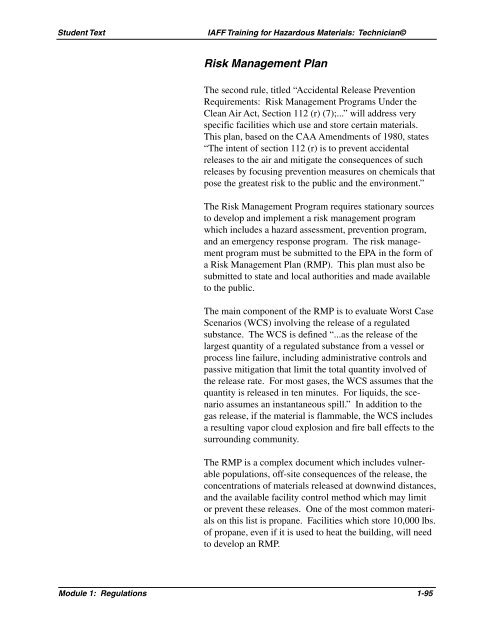Module 1: Regulations - International Association of Fire Fighters
Module 1: Regulations - International Association of Fire Fighters
Module 1: Regulations - International Association of Fire Fighters
Create successful ePaper yourself
Turn your PDF publications into a flip-book with our unique Google optimized e-Paper software.
Student Text IAFF Training for Hazardous Materials: Technician©<br />
Risk Management Plan<br />
The second rule, titled “Accidental Release Prevention<br />
Requirements: Risk Management Programs Under the<br />
Clean Air Act, Section 112 (r) (7);...” will address very<br />
specific facilities which use and store certain materials.<br />
This plan, based on the CAA Amendments <strong>of</strong> 1980, states<br />
“The intent <strong>of</strong> section 112 (r) is to prevent accidental<br />
releases to the air and mitigate the consequences <strong>of</strong> such<br />
releases by focusing prevention measures on chemicals that<br />
pose the greatest risk to the public and the environment.”<br />
The Risk Management Program requires stationary sources<br />
to develop and implement a risk management program<br />
which includes a hazard assessment, prevention program,<br />
and an emergency response program. The risk management<br />
program must be submitted to the EPA in the form <strong>of</strong><br />
a Risk Management Plan (RMP). This plan must also be<br />
submitted to state and local authorities and made available<br />
to the public.<br />
The main component <strong>of</strong> the RMP is to evaluate Worst Case<br />
Scenarios (WCS) involving the release <strong>of</strong> a regulated<br />
substance. The WCS is defined “...as the release <strong>of</strong> the<br />
largest quantity <strong>of</strong> a regulated substance from a vessel or<br />
process line failure, including administrative controls and<br />
passive mitigation that limit the total quantity involved <strong>of</strong><br />
the release rate. For most gases, the WCS assumes that the<br />
quantity is released in ten minutes. For liquids, the scenario<br />
assumes an instantaneous spill.” In addition to the<br />
gas release, if the material is flammable, the WCS includes<br />
a resulting vapor cloud explosion and fire ball effects to the<br />
surrounding community.<br />
The RMP is a complex document which includes vulnerable<br />
populations, <strong>of</strong>f-site consequences <strong>of</strong> the release, the<br />
concentrations <strong>of</strong> materials released at downwind distances,<br />
and the available facility control method which may limit<br />
or prevent these releases. One <strong>of</strong> the most common materials<br />
on this list is propane. Facilities which store 10,000 lbs.<br />
<strong>of</strong> propane, even if it is used to heat the building, will need<br />
to develop an RMP.<br />
<strong>Module</strong> 1: <strong>Regulations</strong> 1-95
















